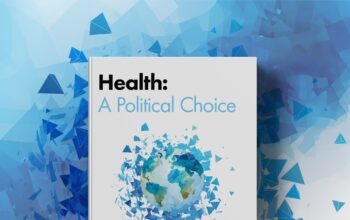How far we have come and how far we have yet to go
Against the backdrop of increasing concerns around Omicron, last week we convened a media briefing on the biopharmaceutical industry’s efforts over the past year since the first COVID-19 vaccine was administered.
This was a unique opportunity to share insights from the Biotechnology Innovation Organization (BIO) and the Developing Countries Vaccine Manufacturers’ Network (DCVMN) and the IFPMA. These three trade groups represent most of the major players in the COVID-19 vaccine manufacturing response. Together we provided an overview of what’s gone well and less well in 2021 and some insights into key issues for 2022, with three main takeaways.
1. The unprecedented successes of science and the biopharmaceutical industry in the past year were possible thanks to partnerships, sharing of information, and a strong innovation eco-system.
Dr Michelle McMurry-Heath, President and CEO of BIO summed it up well by saying that “this has been a phenomenal year for science”, and as a result, the world is seeing a decoupling of SARS-CoV-2 infection from death and disability, which was one of the initial aims.
The year 2021 saw a historic manufacturing scale-up from zero to 11.2 billion and the rollout of the largest immunization campaign in human history. Vaccine manufacturers, from the biotech sector to developing and developed countries, have mobilized resources, forged partnerships, built new production and supply lines, teams to oversee them, and developed new logistics and distribution channels to meet the demand of the hour. It hasn’t been without bumps in the road. In March this year, colleagues from BIO and DCVMN joined us with the Chatham House to identify solutions to bottlenecks seen in the supply chain, trade barriers, export restrictions and scarcity of raw materials. Some of the most seasoned and experienced biological contract manufacturers are not where they wanted to be or failed in terms of scaling up.
The global monthly production capacity for COVID-19 vaccines is 1.4 billion, according to life science analytics firm, Airfinity. To put it into perspective, before the pandemic, the annual production of all vaccines, seasonal flu included, was between 3 and 5 billion.
Sai Prasad, Executive Director of Quality Operations at Bharat Biotech and President of the DCVMN, highlighted the massive scale of industry effort from innovation and product development to manufacturing and distribution: “The complexity of vaccine development and manufacturing cannot be overstated, which is why the production levels we are seeing today merit to be celebrated. In our industry, technology transfer is not as easy as we think. We are one of the most complex industries, every vaccine goes through several regulatory processes and 40 or 50 disciplines of people are required in a vaccine manufacturing company. So, it’s not as easy as somebody waving off IP rights. That’s a start but it has to be followed up with voluntary technology transfer and hand holding right from the design and building of capacity and access to reagents to manufacturing processes and materials.”
Dr Michelle McMurry-Heath built on this point explaining that there have been “Unprecedented levels of collaboration between large and small biotech companies have enabled the breakthrough innovation – in the form of vaccines and therapeutics – we need to fight COVID-19,” she said.
Over 300 partnerships around the world were established to increase manufacturing output, 229 of which rely on technology transfer, sharing of know-how, and training specialist personnel to ensure that vaccines produced adhere to rigorous quality standards. Together we could deliver on promises of innovation breakthroughs. We must also recognize the efficient collaboration with regulators, who were willing to work 24/7 to speed up assessing the data without cutting corners, conducting rolling reviews.
2. The remarkable manufacturing scale-up is overshadowed by shared concern of vaccine inequity and persistent low vaccine coverage rates in low-income countries.
More than half of the global population has now received at least one dose of a COVID-19 vaccine, but, whether it’s politicians or industry, we need to do better in 2022 and beyond. We know that the world is depending on us to do more, and go further. Equitable rollout and distribution this year has been a missed target, as we continue to see significant disparities in vaccination rates across the world. Thankfully, dose-sharing is gaining momentum. COVAX is ramping up fast to ensure doses are distributed equitably around the world, shipping over 790 million COVID-19 vaccines to 144 participants (as of 21 December).
We call for greater commitment and urgency to remove the barriers which prevent vaccines from getting administered. “As doses leave factories, it is vital that they reach those who need them the most,” said Prasad.
The global challenge in guaranteeing widespread access to vaccines has transformed from one concerning supply constraints to one regarding the ability to quickly administer the vaccines. This surge effort, moving from vaccines to vaccinations, needs support, whether it is sufficient political prioritization, funding, infrastructure and human resources to deliver vaccines safely.
As the Airfinity report has shown, the current output from vaccine manufacturers now and in the months to come, is enough to vaccinate all those in need. We expect to see 8.6 billion vaccines produced by the end of June 2022. Even with a third round of vaccines used to fend off the Omicron variant, there will be a surplus of more than 1.3 billion vaccines.
Even more urgently, concrete measures are needed to support COVID-19 vaccine uptake in countries with low vaccination rates. There is a lot that politicians can do, but industry and the global health community more broadly, need to do better to make sure that we move from vaccine supply to vaccination, which should be the order of the day for 2022.
3. The road ahead in 2022 will require continuous collaborations, innovation, and investment to expand global access and stay ahead of new variants.
What we have learned with the emergence of the Omicron variant is that there is no silver bullet that will end this pandemic. It needs persistence, innovative agility, political will.
But I am hopeful that, together with the broader scientific community, public health and regulatory bodies around the world, vaccine makers will again bring their experience and expertise to bear on new variants such as Omicron.
I wholeheartedly agreed with Dr McMurry-Heath when she said that “we’re seeing the full realization of our scientific hopes and dreams and our ability to shift and weave as the virus shifts and weaves”. That said, we need to continue to test different delivery routes, combine vaccines – so that we are also vaccinating against flu and other respiratory illnesses at the same time, to cut down on multiple different infections at the same time.
The current intellectual property framework that supports the innovation eco-system will enable the development of new generations of vaccines that provide longer lasting and stronger protection, and are easier to transport, store, and administer, as well as new treatments to respond to current and new variants.
As an industry, from the first days of the pandemic, we said this was business as ‘unusual’. This has led to new ways of working. In 2022, if we do need new vaccines for new variants then we need to build in better equitable access and distribution upfront and not in five years, but now.
I was proud how our three organizations spoke with one voice. In 2022, we will continue to work tirelessly to make sure as many people as possible can benefit from the current COVID-19 vaccines.
Author






